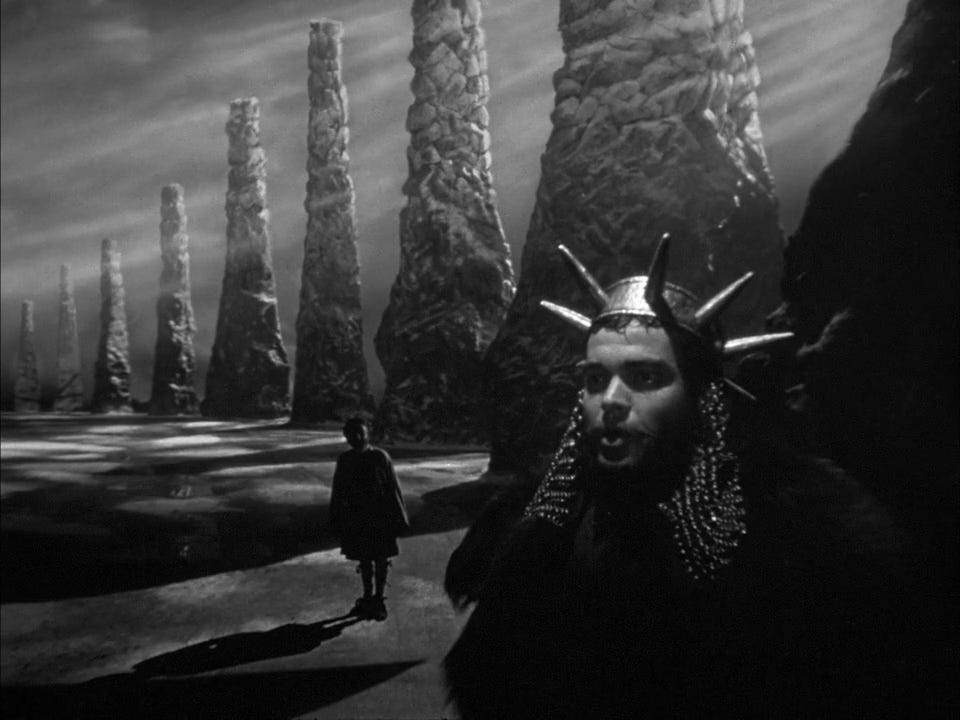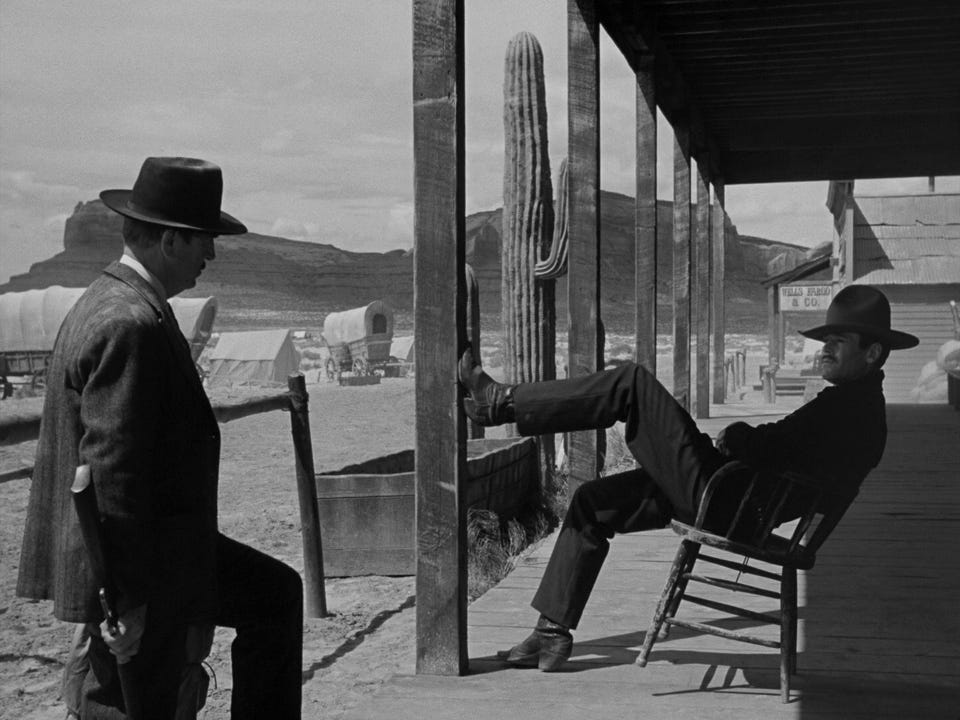March Streaming
Diminish, Go into the West, and Remain: it's Cowboys, Cults, [home] Cassettes, and CantoPop!

Welcome to March streaming.
We’re a little late this month, thanks to a slate of programming that’s as big as Southwestern Skies, and a personal writing process that’s just about as slow as the dispatches on the Pony Express.
This month, we’ve got another one of my absolute favorite types of programs to put together: a genre primer! In the past, we’ve put together streaming programs for noir, melodrama, romantic comedies, the gangster film, etc. But this ain’t Texas [and] ain’t no hold ‘em, so we’re looking back on that most polarizing of all popular genres: the Western. Once one of the most reliable genres in Hollywood, the Western film has largely gone the way of the musical or the live-action family comedy: out. But the Western has a long, complex cinematic history, codified by artistic innovation and cycles of reassessment that constantly push the boundaries of the genre outward, influencing and inspiring generations of contemporary story-tellers. When cultural attitudes shifted in the mid-twentieth century against the regressive politics inherent in white narratives of the West—well pilgrim, that’s when we really started cooking with dynamite!
Elsewhere this month, we’ve got the Other Scourge of the American West: cults, and their depiction in both fiction and non-fiction media; the film career of a red-heeled Hong Kong superstar; Theodore Rex (1995); and a sampling of Shakespearean Adaptations for those accursed Ides, pulled from our archives.
Grab your horse and your angriest flute and meet me on the outskirts of town by dawn, because we’ve got a long ride (and 120+ years of film history) ahead of us.
The Good, The Bad, and the (Profoundly Ugly): The Western Film, a Primer

At the 42nd Academy Awards on April 7, 1970, prop hand-turned-cowboy-turned-draft dodger-turned-Vietnam enthusiast John Wayne finally won his Oscar, capping off a four decade career that traced back to the silent era. John Wayne’s Win—for his performance as the ornery, trigger-happy Rooster Cogburn in True Grit (1969)—was a last gasp of relevance for the former icon of American Western cinema, whose virulent racism, xenophobia, and war-mongering (again, never served himself) made him antithetical to the cultural moment of the late 1960s. John Wayne was a perfect symbolic scapegoat for young people’s well-founded ire: a manifestation of everything wrong with American Exceptionalism (and war hawk machismo). Wayne’s win felt démodé and conciliatory, even (or especially) in 1970, but the night was a watershed moment for the Future of Hollywood, in which the old conservative sect, who—never forget, systematically helped eradicate the old progressive guard during the Blacklist era—squared off against the financial and existential threat of New Hollywood for control over American filmmaking… and guess who walked away victorious? Writing on Midnight Cowboy (1969) for Vanity Fair in 2005, film critic/historian Peter Biskind (who wrote the definitive text on the era, Easy Riders, Raging Bulls: How the Sex-Drugs-and-Rock 'N Roll Generation Saved Hollywood) tries to convey the significance of these two factions quite literally squaring off on Hollywood’s Biggest Night:
“This was a dramatic moment, pregnant with historic significance, marking as it did the symbolic transfer of power from Old Hollywood to New… Audiences may have been flocking to New Hollywood pictures, but the Academy’s Old Guard, the Bob Hopes, Frank Sinatras, and John Waynes, the guys with the stars on the Hollywood Boulevard, were not eager to give their blessing to a bunch of long-hairs. Yet despite a nod to Wayne that year…the tide was too strong. After April, 1970, Hollywood would never be the same.”
John Wayne may have won his mollifying Oscar, but the Top Prize of the night went to John Schlesinger’s Midnight Cowboy (1969), an X-rated gay hustler drama that subverts the iconography of the Western in its examination of fractured American masculinity. The film’s victory over increasingly out-of-touch studio fare like Hello, Dolly! and Anne of the Thousand Days, as well as the expected-favorite, revisionist Western (and the far more mainstream) Butch Cassidy and the Sundance Kid (1969), was a sign of the times. Over the previous summer, the mainstream financial success of Dennis Hopper’s motorcycle epic Easy Rider (1969), released just two months after Midnight Cowboy, had delivered a clear message to Hollywood: out with the old (fogies) and in with the new (European-influenced auteurs). At next year’s Academy Awards, ironically, Chief Dan George (of the Canadian-based Tsleil-Waututh Nation) became the first indigenous American to receive an Oscar nomination for his performance in Arthur Penn’s revisionist Western Little Big Man (1970). To date, no Native American actor has ever won a competitive Academy Award, even though American film—much like American mythology—has historically relied upon the plunder of Native iconography (and the accompanying dehumanization of its indigenous peoples).
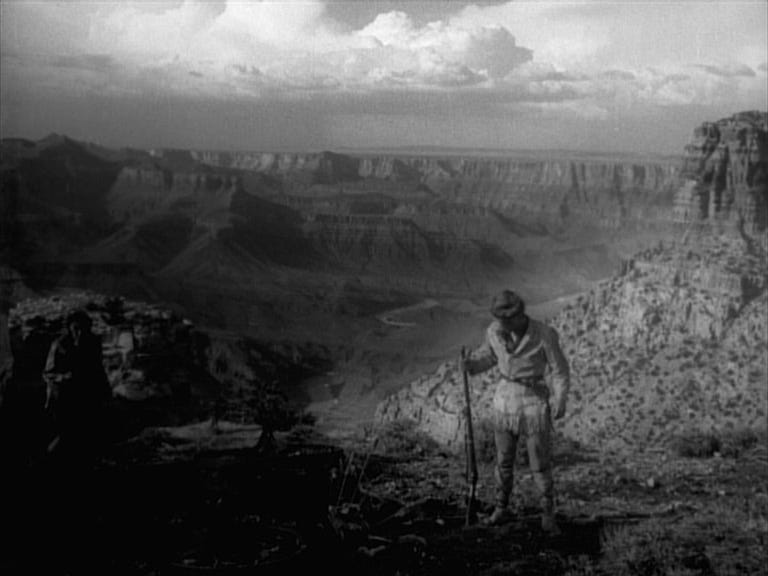
If the American Western became a battleground for the future of American cinema at large at the end of the 1960s, it can’t really come as surprise: the genre has long been a shorthand for the American Experiment, depicting geographical (and ideological) conflict over the untamed lands (and the hidden riches within). From its nascent days in the early film and silent eras to the “singing cowboys” of the early sound era to the homestead melodramas of John Ford and Howard Hawks in the Golden Era, the Classic Hollywood Western was comprised of two ever-warring, irreconcilable forces: “cowboys and Indians.” The good guys are white men backed by guns— be they slaveowners, prospectors, settlers, Confederate soldiers, or otherwise; they must always triumph against the unknown, inherently violent “savage,” who attacks and kidnaps and rapes innocents (white people). This is not really hyperbole: in Michael Curtiz’ Santa Fe Trail (1940), for example, Ronald Reagan and Errol Flynn team-up to stop a murderous John Brown (Raymond Massey, in questionable brownish face) from his tyrannical raid against the poor, defenseless slave owners of Kansas. In earnest! If the 19th century was spent eradicating indigenous peoples and displacing them from their ancestral lands in the name of Manifest Destiny, the 20th century was spent justifying that bloody legacy, and film played an integral role in such myth making. Obviously, this blatant kind of propaganda was in ironic contrast to the offscreen horrors continuously being dealt to indigenous communities, and after World War II, shifting attitudes about genre’s treatment of Native Americans eventually uprooted its legacy from within, as Western films began examining the subjugation of indigenous populations at the hands of racist white settlers.
When production of Hollywood genre films moved to Italy in in the 1950s, in an era known as "Hollywood on the Tiber," English-language films made by Italians began to become insanely profitable, leading to the birth of the so-called "Spaghetti Western” from talented filmmakers like Sergio Leone and Sergio Corbucci, who drew equal inspiration from Japanese samurai films (specifically, Yojimbo) as they did straightforward American Westerns from this Golden Era. That’s actually when we begin cooking with dynamite (a fistful of it, even!), starting a cross-cultural cinematic exchange that transformed our very understanding of Western cinema conventions—such as howling, whistle-backed soundtracks invariably and unforgettably scored by late maestro Ennio Morricone; gun showdowns made tense by cross cutting to extreme close-ups of its participants; and amoral anti-heroes out to survive and make a buck, in that order… and has a harmonica ever been the same since a steely-eyed Charles Bronson mournfully played it in Once Upon a Time in the West (1968)?
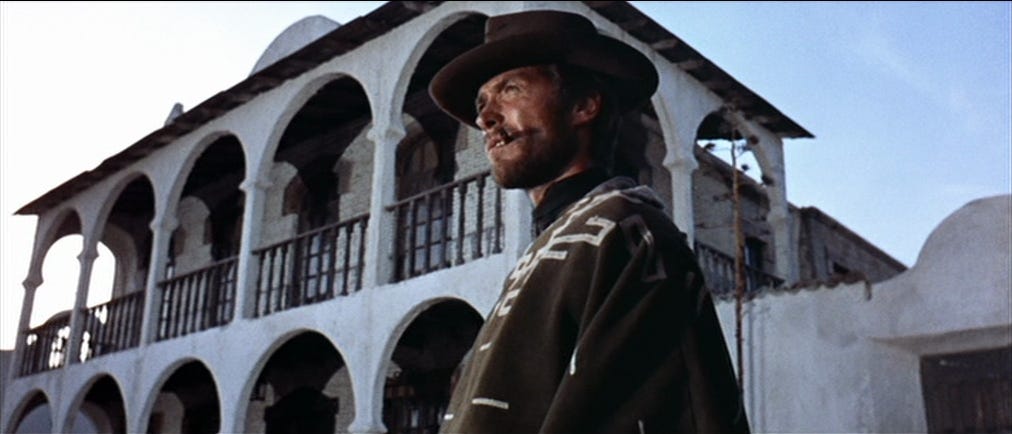
This much-needed external shake-up facilitated the rise of the revisionist and/or post-modern Western, as European-influenced auteurs—fans of the visual styles of American Western auteurs like John Ford, Howard Hawks, and Samuel Fuller—began making films that subverted the false duality of the “cowboys and Indians” / “good guys and bad hombres” mythologies once held as sacrosanct. In the veritable Wild West (hah) of the cinematic landscape of the late 1960s and early 1970s, Westerns could serve as commentary against the Vietnam War (John Wayne be damned); Westerns could re-tell past stories from indigenous perspectives; Westerns could be feminist, or queer-coded, or anti-capitalist. And fascist, of course, always! The Western is a reactionary genre, and it depends upon Manichean notions of ever-warring light and dark, whether it intends to subvert them or not.
Look, it’s easy to write-off the Western, like anything else, for its racist legacy: I’m not one to pretend that it’s easy to sit and watch white actors in redface cartoonishly threaten white women and children in films from the Golden Era of Hollywood (and—in the interest of transparency—I still can’t fucking stand John Wayne). But to do so would be such a disservice to the fraught legacy of Hollywood filmmaking, and would preclude us from enjoying some of the finest films in cinema history. It’s my hope that by programming a messy, contradictory set of films from across all eras, cultures, and political spectrums, we can appreciate the Western for all its gorgeous contradictions. Plus:
This program consists of Western films pulled from (more or less) the four following categories:
Classic Westerns: these are the staples and stand-outs of the genre from the Classic Hollywood era, courtesy of directors like John Ford, Howard Hawks, William A. Wellman, and George Stevens, etc.
International Westerns: these are Westerns made from outside the United States, which either comment on the American West (or re-situate the iconography of the American Western within their own country’s historical context). Here you’ll find Spaghetti Westerns (out of Italy), “Meat Pie” Westerns (set in the Australian Outback), “Ramen Westerns” (out of Japan), Kimchi Westerns (out of South Korea), Sauerkraut Westerns (Western parodies from behind the Iron Curtain), Thai Westerns, and even Telugu Westerns (!)
Auteur Westerns: These are Western films that don’t really fit in a specific category but consist of strong artistic statements from famous filmmakers, people like Nicholas Ray, Jane Campion, Kelly Reichardt, and Rainer Werner Fassbinder (yes, he made a “Western,” and it was never theatrically released, so it’s impossible to find).
Anti-Westerns (or, alternatively, Revisionist Westerns): These are films that knowingly subvert the motifs of the Western genre to criticize American colonialism, settler violence, and patriarchal oppression... and/or eulogize the collapse of the Wild West in the name of progress and “civilization.”
Keeping this basic framework in mind, I’ve put together a list of 200 Westerns—from the earliest days of narrative cinema up through our current moment. It’s my hope that you’ll find one in here that tickles your fancy, or challenges your assumptions about the genre. Or maybe one that just makes ya mad as hell, who cares! Courage is being scared to death but saddling up anyway.
Jim Takes Me Down, He's a Fire Eater: Cult(s) Cinema

Last year, I found myself consuming a deluge of cult media — to clarify, that’s media related to and about cults, not media with a cult following — on every manner of streaming service. On [HBO] Max, that included The Garden (2023) — an awful Discovery channel “documentary series” about a “TikTok viral” prepper cult that “Max” is deliberately trying to pass off as an HBO documentary on the convoluted new streaming platform that bares both brands—which is less a documentary about a real, burgeoning cult and more a fascinating cultural text demonstrating the extent to which young people have been trained on “how” to “act” in a cult-based documentary. We've now gotten to the point where true-crime docs (and cult docs in particular) are as ubiquitous as any other genre, so it was only a matter of time until cult documentary subjects began performing directly for the camera, selling the story. I couldn’t help but wonder It’s hard not to wonder if we’ve reached the point in our cultural cycle where these films/series do little more than partially legitimize and amplify toxic voices who would otherwise have an extremely limited reach and perpetuate the mythology of cult leaders. In the last few years alone, a glut of documentaries dedicated to internet-based cult leaders have fed the content-hungry streaming market, all of which are certainly not created equal. On the one hand, you have Mother God, of Love Has Won: The Cult of Mother God (2023), who brainwashed her internet-culled followers so well that they refused to take her to a hospital when her body began shutting down, finding it anathema to her teachings… then you have people like Teal Swan, who absolutely has not done anything to warrant an entire documentary series like The Deep End (2022), even if it was developed for Freeform (and easily foisted onto streaming, so that no one knows that it was developed for Freeform).
At a certain point, we might question our obsession with these films and shows and the end-game to our consumption of them, particularly as more cult-centric media adopts the streaming-friendly “miniseries” format. It’s not as if cults are irrelevant in our current moment; they’ve just evolved to reflect our particular hellscape of late-stage capitalism. The New Age “spiritual gurus” of the late 20th century have been replaced with pricey “personal development” courses, MLMs, and boutique pastor-focused Christianity... hell, even the Mormon Church, a breeding ground for extremist fringe cult organizations, has made significant cultural in-roads lately via TikTok and product blogging, without people ever really scrutinizing the intent of their messaging. For every thoughtful documentary like Seduced: Inside the NXIVM Cult (2020), which earnestly tries to educate people on the dangers of coercive control and groupthink, there seems to be a true glut of content more akin to a freak show: come laugh at these delusional losers and how much better you are than them. It’s the oldest trick in the game: we watch the latest doc, we laugh at the spaceships and the Nikes and the flirty fishing (or cry at the branding and the Kool Aid and the forced marriages)… and we move on with our lives, passively accepting (at best) and/or kowtowing (at worst) to mainstream religious and business organizations that have systems of abuse baked into their very foundation... and don’t pay taxes.
This program is a mix of documentaries, mini-series, and fictional film and television programs that cover (or draw inspiration from) real-life cult organizations. The “Big Two” of cult leaders, to me, are Jim Jones and Charles Manson, and you’ll find a lot of film and television inspired by these two men in here, but a lot of other interesting oddities as well. Sure, you know that Shinzo Abe was assassinated over his ties to the Unification Church (aka “the Moonies”), but do you know about the Laurence Olivier-starring Korean war film — Inchon! (1981) — that was funded by Reverend Sun Myung Moon and has never been released to home video? Do you know which Manson Family documentary was deemed damaging to Squeaky Fromme’s ability to receive a fair trial after her attempted assassination of Gerald Ford? Just how close was I to finding myself in a Sarah Lawerence-type situation freshman year at NYU (closer than you might immediately assume)? And which false prophet went on to star in the blatant Star Wars rip-off Starcrash (1978)? Learn all this and more, with a series of programs that will help you realize your true potential this cult(s) cinema sampling, generated from hours spent watching these damn things.
There was a Boy… a Little Shy and Sad of Eye: the Cinematic Legacy of Leslie Cheung

“I've heard that there's a kind of bird without legs that can only fly and fly, and sleep in the wind when it is tired,” Leslie Cheung Kwok-wing, playing unsettled playboy “Yuddy,” expresses in Wong Kar-wai’s Days of Being Wild (1990). “The bird only lands once in its life... that's when it dies.” It would be cheap and easy to compare Hong Kong superstar Leslie Cheung to American sex symbol James Dean: two beautiful men who challenged 20th century ideas of gender and sexuality, taken from us far too soon in two terrible accidents that sent shockwaves through popular culture, breaking young hearts in perpetuity and forever giving their onscreen image a loaded, tragic sense of melancholy… the beautiful, tortured young man who sleeps on the wind (and dies when he lands). But a more apt comparison for Western audiences might be to liken him to a Chinese-language David Bowie: a boundary-breaking, gender-bending, and immensely talented multi-hyphenate performer who helped put Cantopop — and a resurgent Hong Kong cinema — on the international map. Beginning in 1977, with his first-runner-up performance of Don McLean’s “American Pie” at the Asian Music Contest at just 20 years old, “Leslie” (as he’s still called by his still-devoted fans, along with “Gor Gor,” which is Cantonese for “big brother”) had an immensely successful recording carer in the 1980s, making him one of the definitive “teen idols” coming out of the entertainment hotbed of Hong Kong. Though lesser known for his music than his acting in the Western world, here’s some perspective on his global cultural impact: in 2010, CNN conducted an international poll of the 5 most iconic musicians of all time, which rounded-up the usual suspects — Michael Jackson, The Beatles, Elvis Presley, Bob Marley — as well as Leslie Cheung… something that is probably only surprising to those of us outside of the Asian Entertainment World, where he still looms larger than life.
After several well-received efforts to crossover into Hong Kong cinema, he made his breakthrough appearance in John Woo’s groundbreaking first “heroic bloodshed movie,” A Better Tomorrow (1986), which also introduced Chow Yun-fat to the world; he’s third-billed, but he steals the show as the film’s pure hearted representative of the titular tomorrow. Leslie began with working with somer of the definitive creatives of the Second Hong Kong New Wave, beginning with queer filmmaker Stanley Kwan on the painfully beautiful historical ghost story, Rouge (1987), which starred the young performer as a rich bachelor opposite his friend (and fellow tragic Cantopop star) Anita Mui, playing the sex worker who steals his heart, to tragic ends. He’d go on to work with internationally beloved auteur Wong Kar-wai—in films like Days of Being Wild (1990) and Ashes of Time (1996)—and appear in several all-time classics of Hong Kong cinema, including Ronny Yu’s quintessential wuxia film The Bride with White Hair (1993) and Lunar New Year comedy cult classic All’s Well, Ends Well (1992). These films are so disparate, but Leslie bodies all of them: equally adept at comedy and tragedy, musical or otherwise, he’s so magnetic, and—yes, so, so stunningly beautiful.

He drew international attention for his acclaimed performance in Chen Kaige’s Farewell My Concubine (1993)—to-date the only Chinese-language film to have won the Palme d’Or—playing an opera performer at the turn of the century who is in unrequited love with his childhood friend, a fellow performer in the Peking Opera. A source of censorship and controversy in mainland China (due to its depiction of homosexuality and state-sanctioned violence under the CCP), the film was restored and re-released last year, drawing insane crowds to NYC repertory theater Film Forum, where it continually sold out; the streets still want Leslie Cheung! Leslie further fueled his international cult reputation—and legacy as a queer icon—by starring in Wong Kar-wai’s zeitgeist gay break-up movie, Happy Together (1997), opposite Tony Leung, another of Chinese-language cinema’s biggest stars, who plays his tortured ex-boyfriend. His performances in these films feel so raw and uncannily honest that they blur lines between life and screen, as well as individual and performer. It brought him an intense amount of scrutiny within Asian media, which speculated for years about his sexuality and the nature of his relationship with childhood best friend Daffy Tong, who was his partner up until his death.
After years of social pressure living as an openly bisexual man in a socially conservative environment and (while battling lifelong depression), the 46-year old performer died by suicide in 2003, jumping from his hotel room at the Mandarin Oriental in Hong Kong in a development that shocked Eastern media and devastated his legion of fans, who still gather at the site to pay tribute. Leslie Cheung was tortured, and he was beautiful—far too beautiful for this ugly, hateful world—but the legacy he left behind cannot be defined by the circumstances of his passing, even if at times the tortured roles he played onscreen seem to mirror his offscreen suffering. Despite how isolating and risky it must have been to be one of the few openly out performers in Chinese-language entertainment, it never stopped Leslie from taking openly queer or queer-coded roles, leaving behind a remarkable, unusual filmography that epitomizes Hong Kong filmmaking at its very best (and captures a last moment in time when fairly progressive films out of Hong Kong could flourish within an increasingly conservative Chinese-language film industry). He was incredibly brave, and he inspires me to turn towards life’s beautiful things, even amidst so much ugliness. It really is like the man in the song says: the greatest thing you’d ever learn is just to love, and be loved in return.
The (Forgotten) History of the “Direct-to-Video” Release
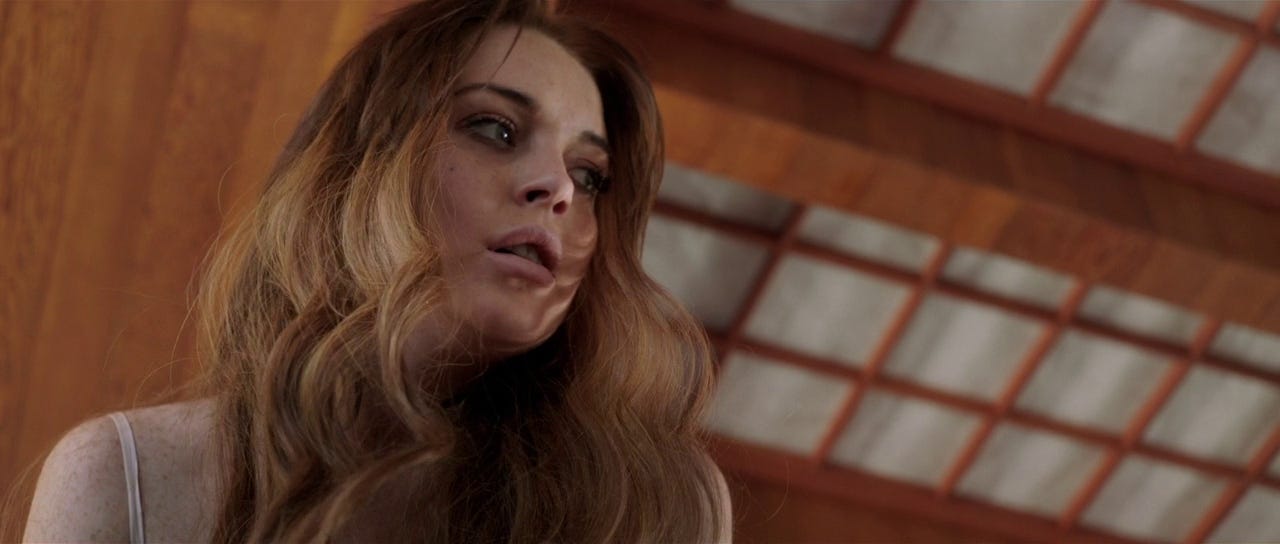
The home video market of the late 20th century, concurrent with the rise of home video rental stores, absolutely transformed Hollywood filmmaking, much like direct-to-streaming releases have in the 2010s and beyond. In the early 1990s, studios realized that they could cut distribution costs and generate serious coin by directly distributing certain niche content to home video formats like VHS (and eventually DVD… and eventually, Video-on-Demand platforms). One of the earliest success stories was Disney’s first direct-to-video release, Return of Jafar (1992), an Aladdin sequel so massively profitable that it encouraged the company to send a slew of sequel properties directly to VHS for purchase/rental in the following years, including Aladdin and the King of Thieves (1996), Beauty and the Beast: The Enchanted Christmas (1997), Pocahontas 2: Journey to a New World (1998), The Lion King II: Simba's Pride (1998), The Little Mermaid II: Return to the Sea (2000), and Cinderella II: Dreams Come True (2002)… among many more to come. You can easily imagine why a parent— desperate for content to put in front of their child before the creation of iPads and Cocomelon— would want plenty of viewing options to choose from. Children’s media became a major staple of this direct-to-consumer style of distribution, alongside action / fight movies like Undisputed II: Last Man Standing (2006) and Universal Soldier: Day of Reckoning (2012); erotic films with boundary-pushing depictions of sex that might be subject to censorship, such as Paul Schrader’s The Canyons (2013) or the Rose McGowan-starring Devil in the Flesh (1998); cult comedies—like Michael Jai White’s Black Dynamite (2009) and Mr. Show spin-off Run Ronnie Run! (2002); and low-budget horror films, such as the massively underrated Trick R Treat (2007) and Mike Flanagan’s first film, Absentia (2011). And, of course, films that were just too awful to even bother sending to movie theaters (such as Whoopi Goldberg/dinosaur buddy cop movie Theodore Rex (1995), the most expensive direct-to-video movie at the time of its release… because it was fully supposed to make it to the big screen!).
As popular as these kinds of media properties could be with home viewers, they also carried them with a significant cultural stigma, which has ceased to hold as much meaning in the digital age: high-budget films are often distributed directly to streaming platforms for immediate home consumption. Because of that dissonance, the films released under the “direct-to-video” model aren’t really discussed as much by film historians, who tend to concentrate on the home video systems themselves and the myriad ways in which they disrupted mainstream American filmmaking; film publications don’t really discuss these properties on a critical level, because of their perceived low-brow status. But what of the films themselves? Are there shared qualities and characteristics between them, aside from genre? Are they employing the medium of home video in any interesting, format-specific ways? What are we to make of these films, and their placement within larger cinema history? Does a “direct-to-video” label hold weight in our current filmgoing culture, when everything is distributed in the exact same way? For this program, I picked the brain of my fellow genre film fan and direct-to-video expert, Conor Burnett, who helped me come up with a list of the most significant direct-to-video / video-on-demand films, either in terms of sales, cultural significance, or artistic merit (sadly, I was not able to include one of Conor’s suggestions: the Mary Kate and Ashley Olsen video where the child detectives discover a dead body at Sea World). We last collaborated a few years back on a program of Unreleased Films, which are films that, for whatever reason, never received distribution of any kind (something that’s sadly more relevant than ever). He’s a leading thought leader in the field of alternatively distributed media and helped me curate the diverse crop of films you’ll find in here. Some of these films did receive extremely small theatrical releases (or concurrent distribution on other mediums like TV), but to qualify for inclusion, these films were released predominantly in a home viewing format, with a negligible box office. We excluded premium cable films for the sake of medium specificity, and “video on demand” here refers to films that were distributed directly for purchase on digital streaming platforms without first receiving a theatrical distribution; there’s just one direct-to-streaming property featured here, Crouching Tiger, Hidden Dragon: Sword of Destiny (2016), but you’ll see why. Check out these goofy, weird, and/or genuinely good curios, and be sure to be kind and rewind Theodore Rex before you take it back to the rental store.
FROM THE VAULT: From the Globe Theater to the Cineplex: Shakespeare on Film
"Beware the Ides of March!” “He is a dreamer; let us leave him; pass."
Inspired by Joel Coen's recent adaptation of Macbeth — as well as those infamous ides everyone keeps talking about — we're looking at film adaptations of the plays of William Shakespeare. In school, I always balked at having to read Shakespeare, because it was hard, and found little joy in watching adaptations of his work (I'm infamously on record in the Dallas Morning News saying that the one thing I could change about my school was "less Shakespeare and more Arthur Miller," which is both incredibly pretentious—because I was 17—and a thinly veiled insult at the McCarthyism of the Texas Public School System that has only gotten worse). But something definitely shifted for me as I grew up, because now I really enjoy Shakespearean adaptations. When you think of a Shakespearean film, what immediately comes to mind? And which actor leads the charge? For me, it's Kenneth Branagh's Hamlet, though most folks I casually surveyed said it is Leonardo DiCaprio in Baz Luhrmann's Romeo+Juliet:
Leo: Why then, O brawling love! O loving hate!/ O any thing, of nothing first create!/ O heavy lightness, serious vanity, Misshapen chaos of well-seeming forms...
Thom Yorke: And nothin/nothiiiiiiin/nothin....
Something I never really appreciated and learned about while researching this program is how the language of Shakespearean film had to be developed as much as film language itself: the earliest sound adaptations are little more than staged re-creations of his plays, filmed in [static] medium shot. It wasn't until Sir Laurence Olivier's directorial debut with Henry V (1944) that a real attempt to translate the Bard for the screen was made; the actor/nascent director famously initially thought that Shakespeare was "unfilmable." With Henry V, Hamlet (1948)—which is still the only Shakespearean film to win Best Picture—and Richard III (1955), Olivier fine-tuned the process of transforming Shakespearean plays into medium-specific works of art, including the use of abstract space and voiceover to deliver soliloquies, [which] would inspire generations of filmmakers like Orson Welles, Franco Zefferelli, Kenneth Branagh, and — yes, Joel Coen! No modernizations or "inspired by" films here: we're dealing directly with films that deal with the Bard's original prose. And no BBC adaptations (I simply can't take that on). Here, we'll get into Orson Welles' "Voodoo Macbeth," how Julie Taymor's Mussolini-inspired Titus Andronicus was slapped with an NC-17 rating, and the time James Cagney Was Bottom.
That’s it for March! I’m something of a wandering ronin myself right now, like Toshiro Mifune in Yojimbo, sidling on up to towns and taking the jobs that come my way. When a man's got money in his pocket he begins to appreciate peace, so consider joining as a paid subscriber if you like my services. See y’all in April!





